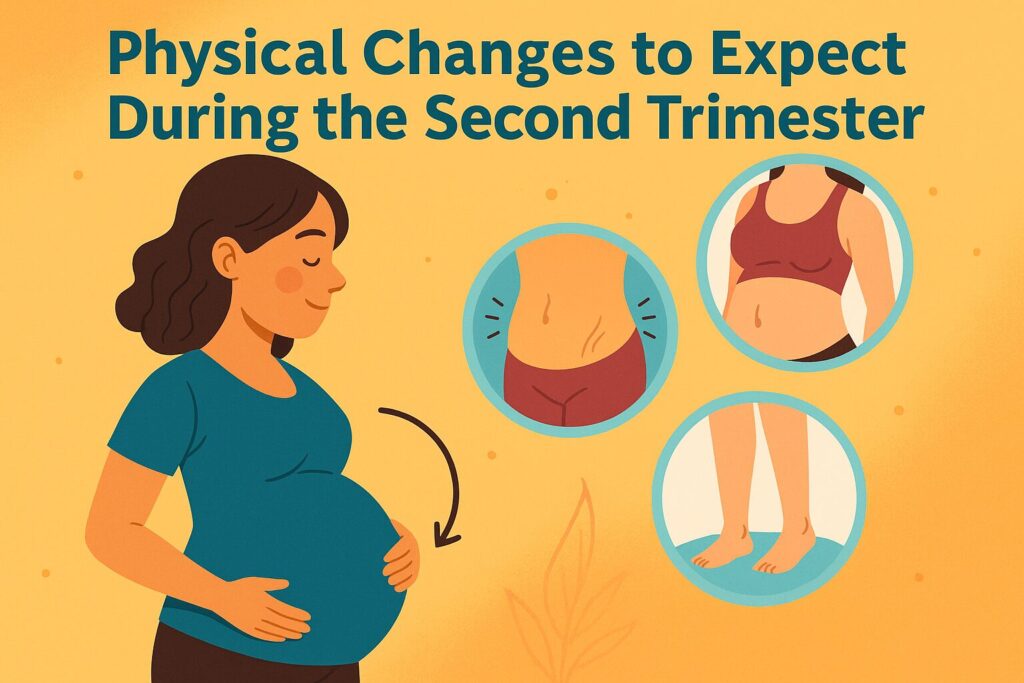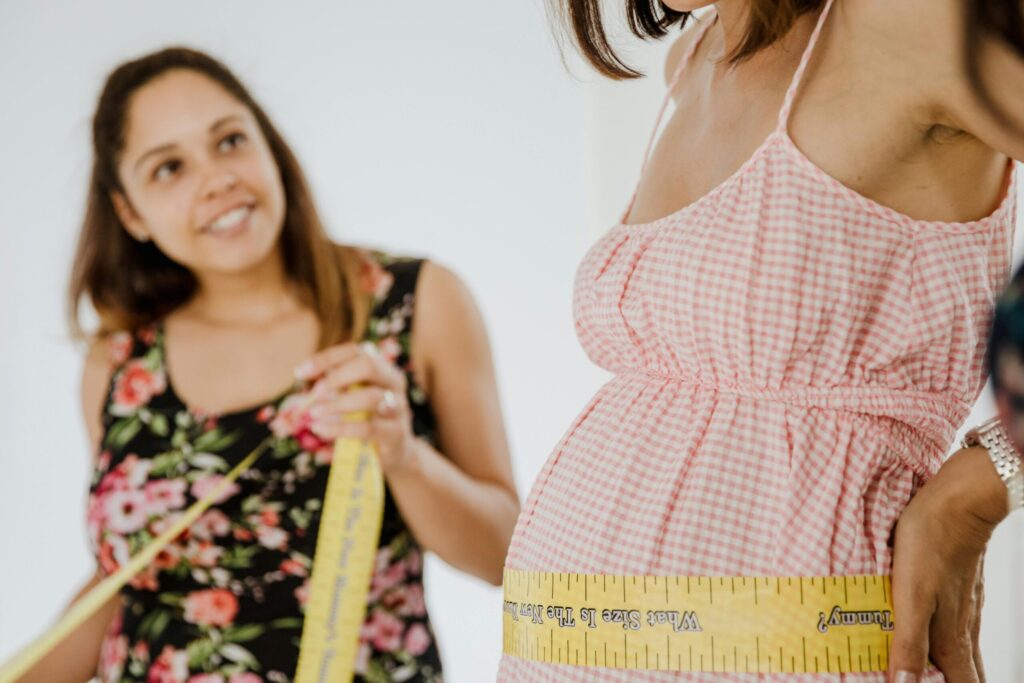The second trimester of pregnancy is often called the “golden period” for good reason. As someone who’s not only guided thousands of women through pregnancy as a midwife but also experienced it five times myself, I can tell you that these middle months bring welcome relief from early pregnancy symptoms while introducing exciting new physical changes. Let’s explore the second trimester body changes you can expect during weeks 13 through 26 of your pregnancy journey.
The Second Trimester: Your Body’s Transformation Begins
After surviving the often challenging first trimester, many expectant mothers find themselves entering a more comfortable phase. I remember with my third pregnancy, it felt like a switch flipped almost exactly at week 13. The constant nausea that had plagued me suddenly lifted, and I found myself with renewed energy. This is typical of the second trimester body changes many women experience.
Energy Levels on the Rise
For most women, the fatigue that dominated the first trimester begins to fade. Your body has adjusted somewhat to the hormonal changes, and your energy often returns—sometimes with a vengeance! I’ve had mothers in my practice joke that they suddenly found themselves cleaning ceiling fans at midnight because they finally had the energy to tackle long-neglected tasks.
This energy boost is the perfect time to establish healthy routines that will serve you well throughout your pregnancy. According to the American College of Obstetricians and Gynecologists, moderate exercise during pregnancy can help reduce backaches, constipation, and swelling, while also improving mood and energy levels.
The End of Morning Sickness (For Most)
One of the most celebrated second trimester body changes is the reduction or complete disappearance of morning sickness. About 70-80% of women who experience nausea and vomiting in early pregnancy find relief by week 16.
I remember one mother in my practice who had been hospitalized twice for severe morning sickness during her first trimester. When she came in for her 16-week appointment, she had a completely different glow about her. “I ate an entire meal yesterday without any issues,” she told me, practically in tears of joy. “I forgot what it felt like to be hungry and actually enjoy food!”
If you’re among the unfortunate few whose nausea persists, don’t hesitate to speak with your healthcare provider. Sometimes adjustments in prenatal vitamins or additional treatments can make a significant difference.
Your Growing Baby Bump: The Most Visible Second Trimester Body Change
When Will I Start to Show?
One of the most common questions I hear from first-time mothers is, “When will I start to show?” The answer varies widely from woman to woman, but for most, the baby bump becomes noticeable during the second trimester.
For first-time mothers, you might not have an obvious bump until 16-20 weeks. With subsequent pregnancies, you’ll likely show earlier. I remember barely showing at 20 weeks with my first child, but by my fifth pregnancy, my regular clothes were uncomfortable by 12 weeks!
Your body type, muscle tone, and even the position of your uterus all influence when your pregnancy becomes visible to others. Some women with longer torsos may show later as there’s more vertical space for the uterus to expand before it must grow outward.
Embracing Your Changing Shape
As your belly grows, your center of gravity shifts. You might notice subtle changes in how you move, sit, and stand. Many women instinctively place their hands on their lower backs for support when standing up or adjust their sitting position more frequently.
With my patients, I always recommend embracing these changes rather than fighting them. Your body is creating the perfect space for your baby to grow, and each change serves an important purpose in that process.
Skin Changes During the Second Trimester

The Pregnancy Glow Is Real
That legendary “pregnancy glow” often makes its appearance during the second trimester body changes. Increased blood volume (about 50% more than pre-pregnancy) brings more blood to the skin’s surface, creating a rosy, luminous appearance. Additionally, increased oil production can give your skin a slight sheen.
Not all skin changes are as welcome, however. About 70% of pregnant women develop the “mask of pregnancy” (melasma)—darkened patches on the face, particularly across the cheeks, forehead, and upper lip. I experienced this with all five of my pregnancies, and while it can be concerning for those who don’t expect it, rest assured that it typically fades after delivery.
The American Academy of Dermatology recommends using broad-spectrum sunscreen with SPF 30 or higher daily, as sun exposure can worsen melasma.
Stretch Marks and Skin Elasticity
As your belly, breasts, and hips expand to accommodate your growing baby, stretch marks may appear—usually in the second half of the second trimester. These pink, red, or purple streaks appear as the skin stretches rapidly, causing tiny tears in the supporting tissues.
Despite countless products claiming to prevent stretch marks, genetics play the largest role in determining whether you’ll develop them. However, keeping your skin well-moisturized can help with the itchiness that often accompanies stretching skin.
I always tell my patients what my grandmother told me during my first pregnancy: “Stretch marks are your tiger stripes—you’ve earned them through the powerful process of creating life.” While they may fade to silvery lines over time, they’re a permanent reminder of the amazing work your body has done.
Breast Changes Continue
Your breasts began changing in the first trimester, but these changes continue and often accelerate in the second trimester.
Preparing for Milk Production
By mid-second trimester, your breasts may increase by as much as two cup sizes as milk-producing tissues develop. The areolas (the darker skin around the nipples) often expand and darken—a natural visual guide to help newborns find their food source.
One change that sometimes alarms my patients is the appearance of small bumps on the areolas called Montgomery’s tubercles. These are completely normal and actually serve an important purpose: they secrete oils that keep the nipples clean and supple in preparation for breastfeeding.
I recommend investing in good supportive bras during this time. Many women find that sleeping in a light support bra helps manage tenderness, which can continue throughout pregnancy.
Internal Changes You Can Feel
The Magic of First Movements
Perhaps the most magical of all second trimester body changes is feeling your baby move for the first time. This sensation, called “quickening,” typically occurs between weeks 18-22 for first-time mothers and sometimes earlier in subsequent pregnancies.
I still remember the first flutters I felt with my eldest—I was sitting quietly reading a book at about 19 weeks along, and suddenly felt what seemed like tiny bubbles popping inside. I wasn’t sure if it was the baby or just digestive gas! But over the next few days, the sensation became more distinct.
Many mothers describe early movements as feeling like butterflies fluttering, fish swimming, or even popcorn popping inside their belly. By the end of the second trimester, these movements become stronger and more recognizable as definite kicks, rolls, and jabs.
Changes to Your Digestive System
As your uterus grows upward and outward, it begins to push against your digestive organs. This can lead to some uncomfortable second trimester body changes, including:
- Heartburn and indigestion
- Constipation
- Occasional shortness of breath as your lungs have less room to expand
I’ve found that eating smaller, more frequent meals helps many women manage these symptoms. Staying well-hydrated and maintaining regular physical activity also promotes healthy digestion.
Unexpected Second Trimester Body Changes
Nasal Congestion and Nosebleeds
Due to increased blood volume and hormones that cause swelling of nasal tissues, many pregnant women experience stuffiness and occasional nosebleeds during the second trimester. This condition, known as pregnancy rhinitis, affects about 30% of pregnant women.
One of my patients described it as “feeling like I’ve had a cold for months, but without actually being sick.” Using a humidifier at night and saline nasal sprays can offer relief.
Dental Changes
Pregnancy hormones can make your gums more sensitive and prone to bleeding when brushing or flossing. Some women also experience temporary loosening of teeth due to hormones affecting the ligaments and bones that hold teeth in place.
Regular dental check-ups during pregnancy are important, as poor oral health has been linked to pregnancy complications. Always inform your dentist that you’re pregnant, as certain procedures may need to be postponed.
Embracing Your Second Trimester Body Changes
As both a mother and midwife, I’ve learned that each pregnancy is unique. The second trimester body changes you experience may differ significantly from those of your friends, sisters, or even your previous pregnancies.
What’s most important is tuning into your body’s signals and maintaining open communication with your healthcare provider. Most second trimester changes are perfectly normal, but any severe pain, bleeding, or dramatic swelling should be evaluated promptly.
Remember that these changes, both the comfortable and uncomfortable ones, are all part of the incredible process of creating new life. As your body transforms, take time to connect with your baby through these physical changes—rest your hands on your growing belly, talk to your baby when you feel those magical movements, and marvel at the incredible work your body is doing without any conscious effort on your part.
The second trimester often passes quickly, so take photos, journal about your experiences, and embrace this special time. Before you know it, you’ll be entering the third trimester—the final stretch before meeting your little one face to face.



